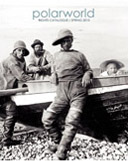 Our ProductsOur Resources |
This website requires the free Flash plugin to be installed.
Polarworld - discover more polar booksThe Arctic Book Review Afterlands: A Novel Afterlands: A NovelSteven Heighton Reviewed by Kenn Harper All of the factual elements of Afterlands are well known to students of Arctic history. It is the story of Captain George Tyson’s "Wonderful Drift on the Ice-Floe," one of the greatest feats of survival in the history of exploration. In the fall of 1872, with expedition leader Charles Francis Hall dead – some say of arsenic poisoning at the hands of the ship’s doctor, Emil Bessels – the vessel, Polaris, is beset by heavy seas and threatening ice. Off northwestern Greenland an order is given to abandon ship, and many of the ship’s crew and passengers take to the ice with the supplies that are hurriedly mustered. But the ship does not sink. Instead it drifts away from nineteen men, women and children who are left stranded on the ice, unable to return to the vessel. They drift for 196 days, southward through Smith Sound, Baffin Bay, Davis Strait, and into the North Atlantic. On April 30, 1873, they are rescued by a Newfoundland sealer, Tigress. No lives have been lost. Amidst strife, both ethnic and racial, the party has survived due in large part to the leadership of Tyson and the hunting abilities of the Inuit men, Joe Ebierbing and Hans Hendrik. Novelist Steven Heighton takes the source material – Tyson’s book, his papers in the US National Archives, narratives of the Polaris expedition - and weaves a story of what could well have transpired on the ice during that half-year of hardship and fear. George Tyson is the nominal leader of the ice floe party. His rival is a German sailor, J. W. C. Kruger, whom Heighton calls Roland Kruger (although Tyson’s own book called him Ronald). This is the story of two strong-willed men from rival nations whom fate places in close quarters for longer than either would have chosen, their national and personal rivalries, and the desire of each for the affections of the enigmatic Tukulito, an “Esquimaux” woman, the wife of Joe Ebierbing. Excerpts from Tyson’s published narrative, adapted and rearranged by Heighton, form the backbone of the story, but they are Tyson’s view. In his book, Tyson trashed Kruger and denigrated Tukulito, promoting himself as the sole white hero of the drift, while showing some grudging admiration for Joe. Heighton’s task is to round out Tyson’s one-sided, self-serving narrative with a more human story, and he accomplishes his task well, through the introduction of national loyalties and sexual tension. For both men, their imagined love for Tukulito is unrequited – the Eskimo woman is a Christian and faithful to her husband – although Kruger manages to receive an unforced kiss between decks on the Tigress after their rescue – “a firm, humid, clumsy kiss,” but a kiss nonetheless. The story begins with Tukulito and Ebierbing’s daughter, Punnie (simply a mispronunciation of the Inuktitut word "Panik" which means daughter), and moves quickly to her inevitable death and burial. Heighton then takes the story back to the Polaris, to the ice-drift and the rescue, and then to the after-stories of the characters. With Tyson, he has some facts to lean on. The man achieves a modicum of fame with the publication of his book, co-written with a woman, E. Vale Blake. For a time he moves on the lecture circuit. Heighton reproduces a playbill advertising a lecture by Tyson – 196 Days on an Ice Floe – for which he charged 25 cents admission. With Tukulito too, there are some facts. She remains for the short remainder of her life in Groton, Connecticut, unable to leave the site of her daughter’s burial. But the real Kruger is an empty slate, which allows Heighton free reign to build his character as "independent, defiant, courageous." His afterstory — which takes him to Mexico, then back to Groton, Connecticut for the burial of Punnie — "springs purely from my own imaginary pursuit," says Heighton in his author’s note. Steven Heighton is an acclaimed Canadian novelist, poet, and short story writer. Afterlands is his most ambitious undertaking, and it works. Like Wayne Johnstone in Navigator of New York, the blend of fact and fancy is plausible and the chronology of events is true to fact. This adds to the believability of a story that is admittedly fiction. The exception is the burial of Tukulito’s and Ebierbing’s daughter, which Heighton has happening on November 23, 1876. In fact, Punnie died a year and a half earlier, on March 18, 1875, her health shattered by the hardships of the ice drift. Why Heighton has rearranged the chronology of this sad burial is not clear. Heighton’s writing exhibits powerful descriptive talent. He paints word-pictures of the High Arctic in stunning starkness as imagined from the unhappy vantage point of a drifting ice floe: "His eyes devour this last wafer of sun. Eastward above billows of tidewater fog the glacial tongues of Greenland are lit up vermilion like flumes of molten ore; to the west, the tors of Ellesmere Land in the glassy air seem touchably close; southward Baffin Bay under pack ice fans out like a pink desert studded here and there with bergs, like crags and mesas of salt rock – a vast coherent landscape drifting south." The sexual rivalry between two dominant men for the affections of the accomplished Tukulito is also plausible, even probable, though there is not a shred of historical evidence to support it. This native woman, almost iconic among northerners, has never been portrayed as an object of sexual desire before. Yet Heighton manages to portray a love scene between Tukulito and her husband, discreetly witnessed by the unsleeping Tyson in the close confines of the snowhut that was their refuge on the floe. Here Joe suggests that Hannah offer herself to Tyson later that night ("This man suffers so without his wife… and his situation here is so difficult. You should comfort him some night. Maybe tonight, when I’m asleep again.") Hannah’s response ("It’s not my custom. We are married, church married.") is met with Joe’s comment ("You always take what suits you of their ways and ours!... What use is a God that makes you so stingy?") In less skilful hands than Heighton’s, this scene and these sentiments would verge on sacrilege. Tukulito is the focal point of the story. Without her presence, the rivalry between Tyson and Kruger would merely be a dispute over control of their ship of ice, fuelled by nationalistic insults and ripostes. But she is present and she dominates, quietly, subtly, as she did on Hall’s previous expeditions. Photographs of her show a woman of external plainness, even homeliness, who radiates an inner calm. Heighton’s verbal portrait of her mirrors the visual evidence: "…her cheeks are always ruddy, red on brown. That vital blush and the strength of life in her eyes cancel out her plainness. She moves with a simple grace of purpose; she’s one of those who perfectly fill whatever space they occupy. For some time after you speak with her, her features will return to your mind in clear flashes." The interplay of cultures mutually incomprehensible is handled with delicacy. Consider this passage: "She has instructed him [Tyson] on the importance of sleeping pressed up against the others when on the ice, yet he resists. Father Hall was like that too, at the beginning, when first travelling with them on Baffin Island, eleven winters ago. She intertwines her feet with the lieutenant’s as she once did with Father Hall. The lieutenant draws closer, as he should. And this is best. If the ship were to rescue them tomorrow, she would be glad again for her cabin and would allow no other man but her husband next to her – and the transition between these sets of customs would be seamless, graceful, and automatic." Physical hunger is a predominant metaphor in Heighton’s story, a surrogate for sexual desire as well as for patriotic pre-eminence. Consider the quotation from Judith Thurman used as an introductory epigraph to the section, "Versions of Loyalty,": "To understand desire, one has to be, or remember having been, hungry." Or this observation which he places in the mouth of Kruger as the German ponders the thefts of food from the communal storehouse: "Out here where there’s so little to tempt one, temptations are that much stronger." Or his own generalized observation when he quotes "Patriotism is the last refuge of the scoundrel," from Samuel Johnson, "Yes, but maybe also the last haven of the hungry, the demoralized and the desperate." I have a few quibbles with the spelling of the few Inuktitut words which make their way into the text. "Utarannaakuluk," a term of endearment which Tukulito whispers to her daughter is missing an initial "n" and is therefore meaningless. It was meant to mean something like "sweet little child." "Kaapiaksukpiit?" - Are you frightened? – should be "Kappiasukpiit?" "Qitunngaujak," for doll, should be "qiturngaujaq." In his author’s note, Heighton says that a more accurate spelling of Tukulito’s name would be Taqulittuq or Tukulirtuq, although there is no evidence for either. Neither is there grounds for claiming that the Inuit woman spelled her own name as Tukulito. In fact it is the sheer variety of spellings of her name in the historical record that has led most writers to refer to her by the name the whalers gave her as a child, Hannah. But Heighton’s version, Tukulito, works just fine. He is in error, though, in claiming that her husband, Ebierbing’s name is now usually spelled as Ipirvik – it is in fact Ipiirvik; the double "i" is an important distinction because vocalic length is significant in Inuktitut. In his final chapter Heighton makes reference to Sheila Nickerson’s book Midnight to the North, and to her description of Punnie’s grave marker in the Starr Burying Ground in Groton. The inscription tells in a few lines the story of the ice drift, and ends with – in Nickerson’s words, which Heighton quotes – "Of such is the kingdom of." And then a blank. Heighton continues: "The last word remains unclear. I think this is right; I think I prefer it blank, uninterpreted, the beloved child and her mother still alive in the silences." Nickerson remarks that she wanted the word to be love, thought it might be, but couldn’t be certain. Heaven, she thought, was another possibility. But she wanted it to be love. I’ve made my own pilgrimage to this sacred site many times, the first in the 1970s and the last two years ago. Like Nickerson and Heighton, I’ve knelt in fron't of the weathered headstone of this well-travelled little girl from Igloolik, over a century dead. I’ve laid flowers on her grave as I pondered the events of her tragically short life and the lives of her parents. It’s touching to suggest that the final word might be "love," but it’s also not true. One needs to move aside the grass at the foot of the grave to see it clearly, but the final word is legible, and it is clearly "heaven." But I’m quibbling and I shouldn’t. Steven Heighton is a masterful story-teller and one of Canada’s finest writers. He has filled in the inevitable blanks in a documented real-life drama, and his knowledge of the historical detail is unimpeachable. He has built conflict out of national incompatibilities and unrequited love, and dared to imagine how the characters pieced their shattered lives back together after the trauma of their ordeal on ice. The Polaris story lay untouched for over a century until a few years ago, fertile ground for historians and novelists. This is by far the most compelling treatment of it to date. |
|
||
follow us  | join us | join us  | home | contact | home | contact
|
||||
|
© Copyright Polarworld Ltd
SiteWizard.co.uk Web Site Design Company |
||||


